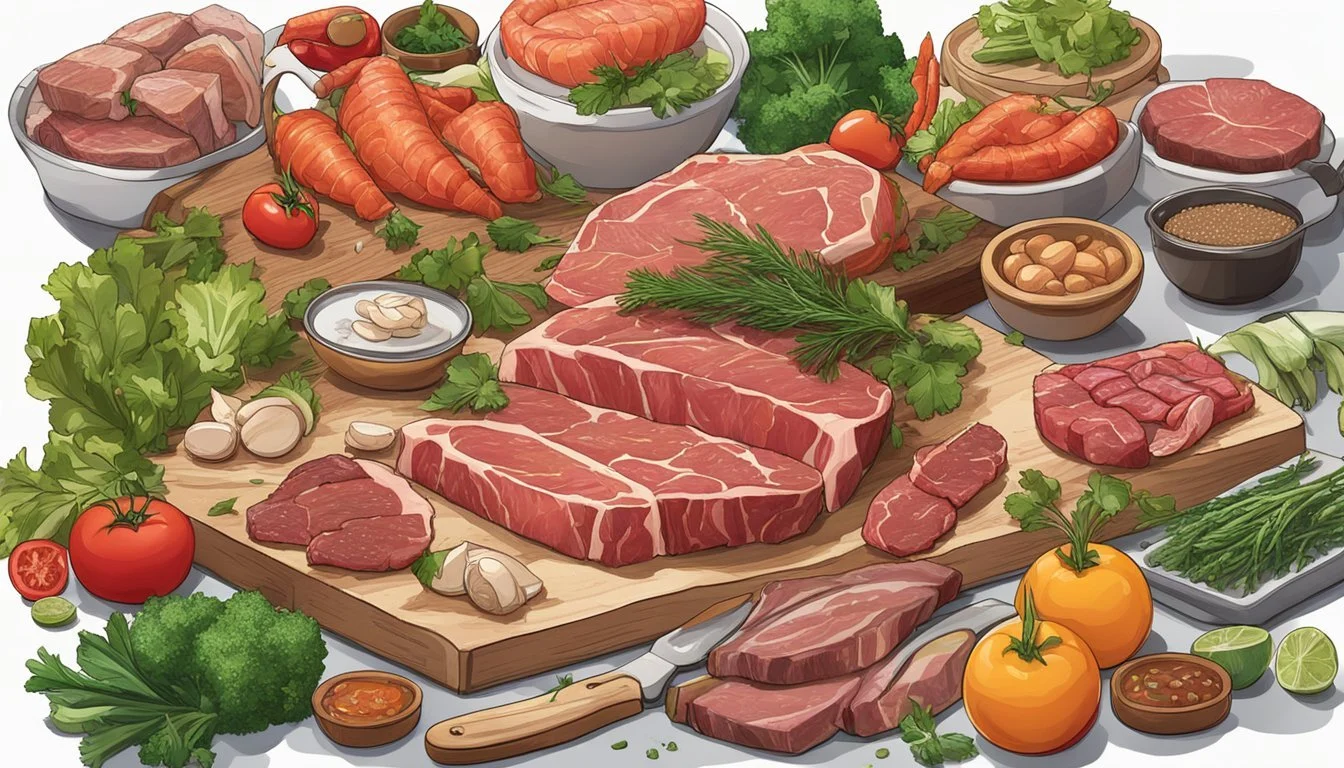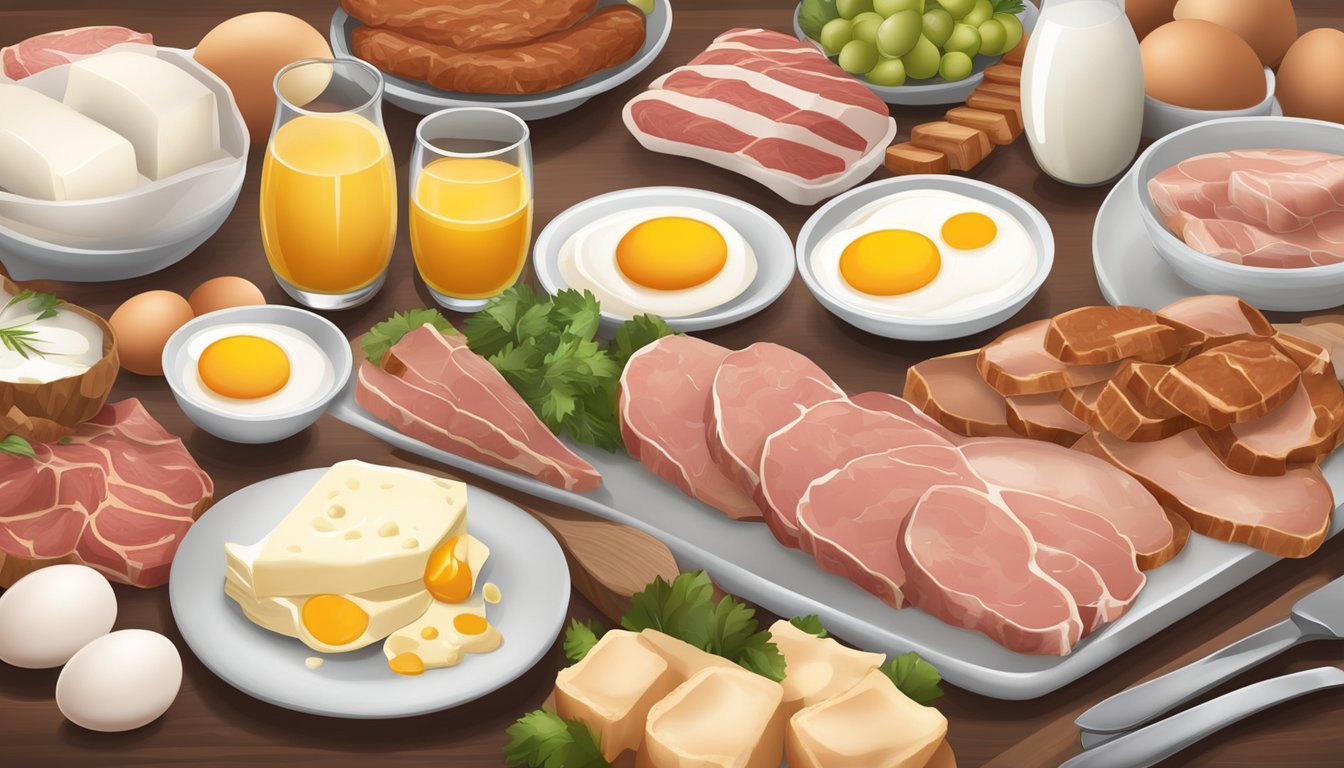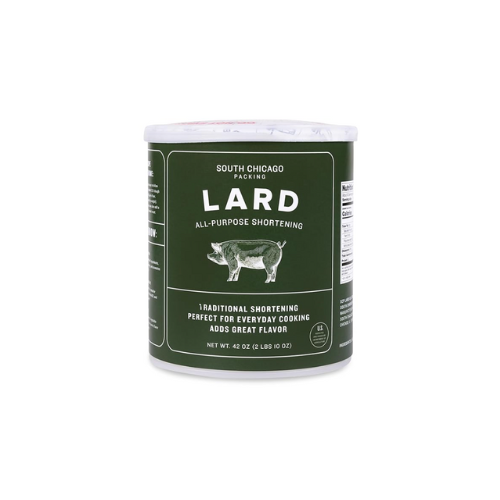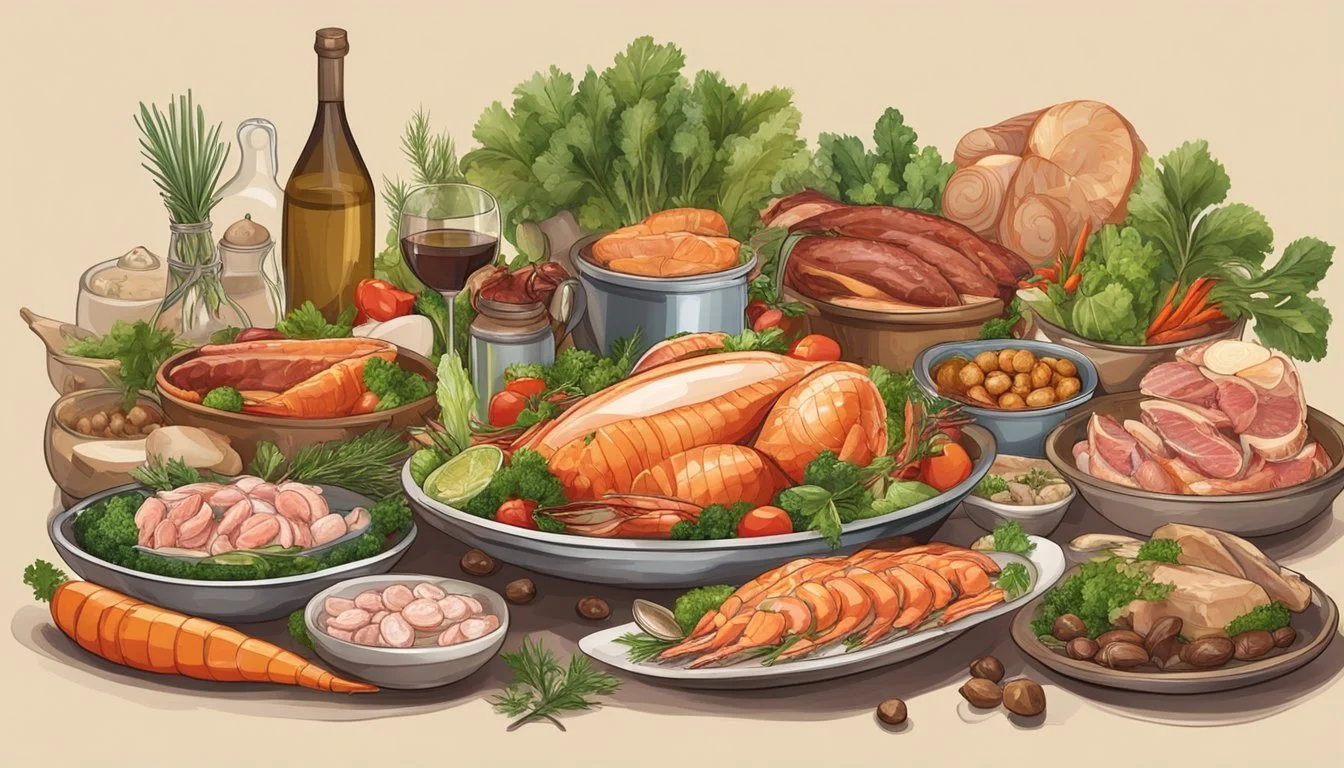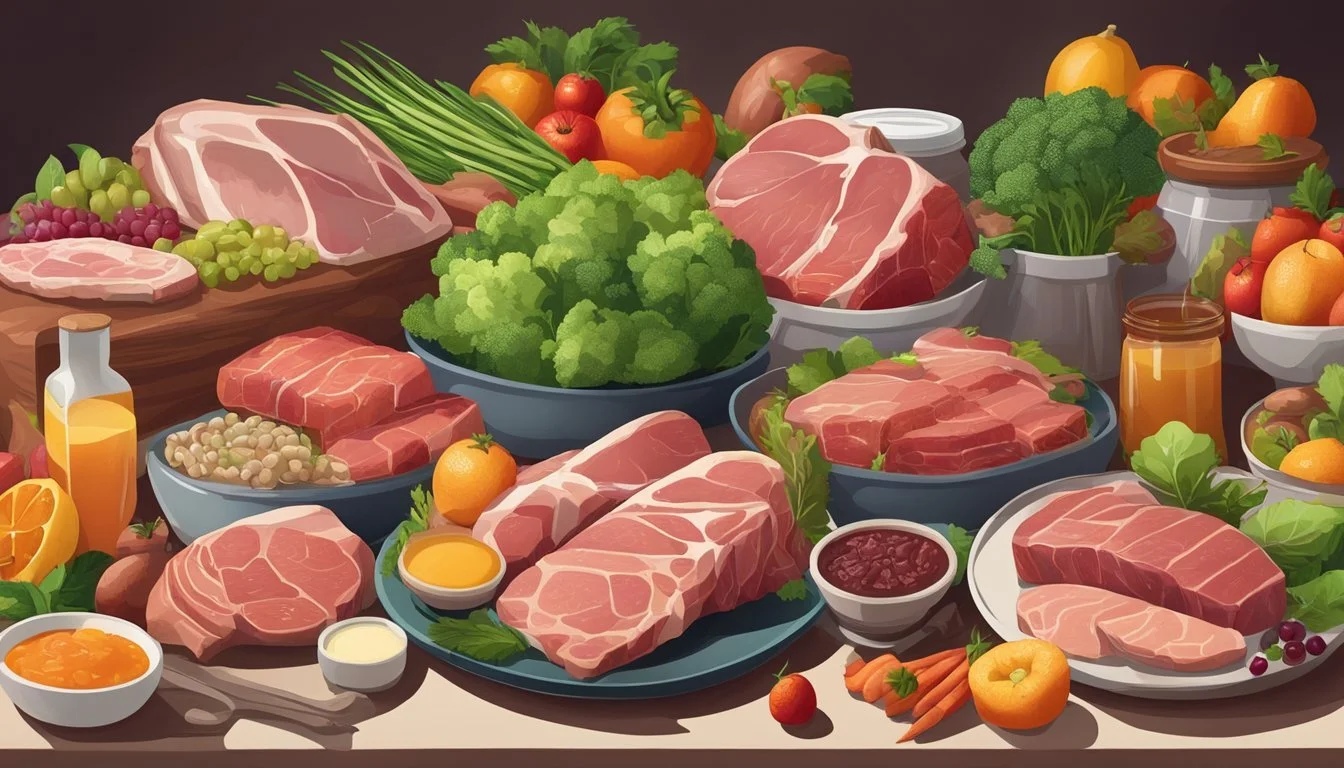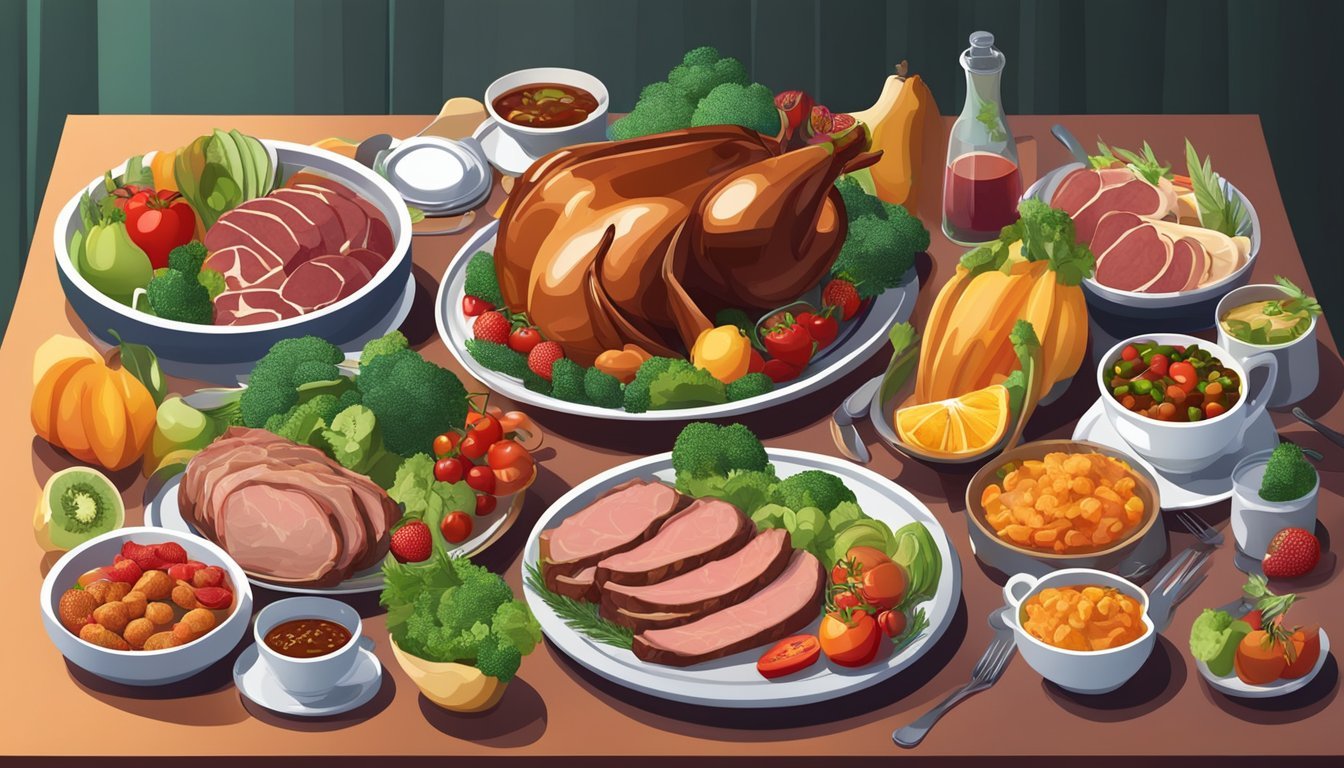How to Plan a Carnivore Diet Menu for Special Occasions
Celebratory Feasts Made Simple
Planning a meal menu for special occasions can be a delightful challenge, especially when adhering to a carnivore diet. This diet focuses on consuming exclusively animal products and is a rigorous, meat-centered way of eating. On special occasions where meals are often central to the celebration, individuals following a carnivore diet must create a meal plan that remains true to their dietary constraints while also offering a festive and enjoyable dining experience for themselves and possibly their guests.
Crafting a carnivore diet menu for these events requires careful selection of high-quality meats and creative preparation techniques. The variety is key – incorporating different cuts of beef, pork, poultry, and fish can keep the meal exciting and palatable. Given the diet's restriction to animal products, the meal plan should also include high-fat options and maybe even organ meats to provide both flavor and nutritional value.
Special occasions might typically feature an array of diverse dishes, but for those on a carnivore diet, the challenge lies in reimagining these events with a meat-only focus. Whether it’s a holiday feast, a birthday, or an anniversary dinner, planning should account for both the scale of the event and the dietary principles of the carnivore lifestyle. This can mean substituting traditional side dishes with carnivore-friendly alternatives and ensuring that cooking methods like roasting, grilling, and searing are employed to bring out the natural flavors of the meat. With attention to detail and a respect for the diet's guidelines, one can create a celebratory spread that is both satisfying and suitable for any special occasion.
Understanding the Carnivore Diet
The carnivore diet focuses on consuming exclusively animal products and eliminates plant-based foods. It emphasizes high protein and fat intake while excluding carbohydrates.
Benefits and Challenges
Benefits:
Weight Loss: The diet often leads to weight loss due to reduced carbohydrate intake and the satiety provided by high-protein foods.
Simple Framework: It eliminates the need to track all macronutrients due to its straightforward approach of consuming only animal products.
Challenges:
Nutrient Deficiencies: This diet can lead to potential deficiencies in certain vitamins and minerals typically found in plant-based foods, including Vitamin C and some B vitamins.
Social and Culinary Limitations: The restrictive nature of the diet can make social dining and varied culinary experiences difficult.
Carnivore Diet Vs. Keto
List of Aspects Comparing Carnivore and Keto Diets:
Primary Focus
Carnivore Diet: Animal products exclusively
Keto Diet: Low-carb, high-fat with some plant-based foods
Carbohydrate Intake
Carnivore Diet: Virtually nonexistent
Keto Diet: Limited to induce ketosis
Protein
Carnivore Diet: High
Keto Diet: Moderate to maintain ketosis
Fat
Carnivore Diet: High
Keto Diet: High, with an emphasis on healthy fats
The key difference lies in the carnivore diet's exclusion of nearly all carbs and ketogenic diet’s specific macronutrient balance to maintain ketosis.
Addressing Nutrient Deficiencies
To prevent nutrient deficiencies on a carnivore diet, attention should be given to incorporate a variety of animal products:
Organ Meats: Rich in vitamins and minerals, including those that might be scarce in muscle meats.
Bone Broth: Can provide minerals like calcium and potassium.
Fatty Fish: High in Omega-3 fatty acids and Vitamin D.
Eggs: Provide a good balance of fat, protein, and essential nutrients like B vitamins and choline.
Considering supplementation for nutrients like Vitamin C and fiber, which are generally not present in adequate amounts in a purely carnivorous menu, can also be important.
I highly recommend purchasing vitamin C and fiber supplement online for a convenient shopping experience!
Planning Your Menu
When planning a carnivore diet menu for special occasions, focusing on meat selection and understanding food list parameters is essential for a successful, enjoyable meal.
Selecting High-Quality Meats
High-quality meats are the cornerstone of the carnivore diet. The main focus should be on beef, such as succulent ribeye steaks (What wine goes well with ribeye steak?) and tender organ meats. For those who prefer variety, including other proteins like lamb, pork, and chicken will enrich the menu. It's recommended to source grass-fed and organic options where possible, as they are often higher in nutrients. Seafood, particularly fatty fish like salmon, mackerel, trout, tuna, and sardines, can also be featured for their omega-3 content.
Beef: Ribeye steak, ground beef, bone marrow
Poultry: Chicken breast, wings
Pork: Pork chops, bacon
Lamb: Lamb chops (What wine goes well with lamb chops?), leg of lamb
Organ Meats: Liver, kidney, heart
Seafood: Salmon, mackerel, trout, tuna, sardines
Food List Inclusions and Exclusions
Creating a precise and appropriate menu involves knowing what to include and what to leave out. Dairy products like heavy cream, butter, ghee, and lard are acceptable fat sources.
Include:
Animal fats: Ghee, butter, lard, tallow
Dairy (if tolerated): Heavy cream
Exclude:
Non-animal products
Processed meat products with additives or fillers
When planning the menu, ensure all dishes align with the carnivore diet's principles to maintain its integrity while celebrating the occasion.
If you're looking for ghee, lard, or tallow, buying it online is your best bet!
Meal Composition and Macros
When planning a carnivore diet menu for special occasions, understanding the balance between protein and fat, as well as managing these macronutrients to align with individual goals, is critical. One must consider the body's requirement for essential nutrients while aiming for ketosis or other health objectives like muscle mass increment or fat loss.
Protein and Fat Ratios
A carnivore diet typically consists of high protein and high fat, with minimal to no carbohydrate intake. Protein should predominantly come from muscle meat, while fat can be sourced from cuts of meat with higher fat content. For example, ribeye steaks are richer in fat compared to leaner cuts like top round. Choosing the right cuts of meat is instrumental in maintaining this ratio.
Fat to Protein Ratio (by calories):
High Fat: 70% fat / 30% protein
Moderate Fat: 60% fat / 40% protein
Lean: 50% fat / 50% protein
This ratio greatly varies depending on the individual's goals and needs. For those aiming for ketosis, a higher fat intake is necessary as fats will be the primary energy source.
Managing Macronutrients for Goals
Managing macronutrients involves aligning the diet with specific objectives. For example:
For Muscle Mass: One might lean towards higher protein intake, ensuring adequate leucine, which is crucial for muscle protein synthesis.
For Fat Loss: A lower fat intake could be more appropriate to create a caloric deficit while maintaining protein to support muscle mass.
For Maintaining Weight: A balanced approach should be taken with caloric intake equating energy expenditure.
It's imperative to adjust macronutrients intake while keeping in mind that a carnivore diet is naturally low in carbs, focusing on nutritional density and satiety to prevent overeating. If followed correctly, this dietary pattern can lead to a state of ketosis, thereby utilizing fat as the primary fuel source. By monitoring body weight and composition, one can tweak their meal plan to suit their evolving dietary goals.
Recipes and Cooking Methods
Planning a menu for special occasions on a carnivore diet focuses on choosing the right cuts of meat, mastering cooking techniques, and tastefully incorporating nutritionally dense organ meats and select dairy products to enhance the richness of the dishes.
Cooking the Perfect Steak
To cook a perfect steak, one must pay attention to the cut selection, seasoning, and cooking method. Ribeye or filet mignon are prime choices. Before cooking, one should bring the steak to room temperature. Seasoning is typically minimal, focused on enhancing the meat's natural flavor—usually just salt and sometimes black pepper are needed. For cooking, sear the steak on high heat to form a crust, then finish to the desired doneness (rare, medium, or well-done) either on a lower heat in the pan or in the oven. A meat thermometer is a reliable tool to ensure the steak reaches the correct internal temperature.
Incorporating Organ Meats
Organ meats, such as liver or kidneys, can be nutrient-dense additions to a carnivore diet menu. Liver can be prepared as pâté or simply pan-fried to preserve its tender texture. For those unfamiliar with the taste, combining liver with more familiar meats, like in a mixed grill, can make it more palatable. It's crucial to not overcook organ meats to prevent a tough and grainy texture.
Liver Pâté Recipe:
Sauté chopped onions and garlic in butter until translucent.
Add diced liver, cook until browned.
Blend with a fork or in a food processor with herbs, creating a smooth, spreadable mixture.
Serve chilled.
When it comes to getting the best deals, buying food processor, online is the way to go!
Dairy and Dairy Alternatives in Cooking
On the carnivore diet, dairy products that are low in lactose, such as butter and ghee, are typically well-tolerated and can be used in cooking. They provide rich flavoring for meats and are excellent for sautéing, basting, and making pan sauces. Ghee has a high smoke point which makes it suitable for searing meats. For those who opt for dairy alternatives, using rendered animal fats like tallow can offer a flavorful substitute.
Dairy usage in recipes:
Top steaks with a dollop of herbed butter post-cooking for added richness.
Use ghee as a base for searing meats or for frying organ meats.
Incorporate bone broth in recipes to add depth of flavor and additional nutrients.
Meal Timing and Frequency
When planning a carnivore diet menu for special occasions, one must consider the appropriate timing and frequency of meals. Strategic planning can help accommodate the dietary pattern and maintain the festive spirit.
Intermittent Fasting and Carnivore Diet
Intermittent fasting involves cycling between periods of eating and fasting. On a carnivore diet, this can be utilized by scheduling an eating window, such as 8 hours of feeding and 16 hours of fasting. This approach can be particularly beneficial when planning for occasions, as one can align the eating window with the event’s meal times.
Breakfast (Skip if Fasting): If not fasting, a small, protein-rich meal such as eggs or a slice of ham can kickstart the day.
Lunch: Should coincide with the beginning of the eating window; options include roasted chicken thighs (What wine goes well with chicken thighs?) or steak.
Dinner: The last meal before the fasting period could be a more elaborate preparation, like a prime rib or lamb chops, suitable for a celebration.
Scheduling Meals for Special Occasions
Meal timing on special occasions should mirror the event's schedule. One should also consider the number of meals that will be feasible:
Single Large Meal: For one-off festivities, a single, substantial meal that showcases a variety of meats—such as a mixed grill platter—can be a focal point.
Multiple Small Meals: If the occasion involves all-day events, smaller, spaced-out meals will be more appropriate.
It is key to pre-plan these details:
Allocate specific times for each meal, ensuring they align with the day's events.
Breakfast: If included, keep it light with foods like bacon or smoked salmon to anticipate larger meals later in the day.
Lunch: A moderate meal that can double as an appetizer, such as sliced cold cuts or shrimp cocktail. (What wine goes well with shrimp cocktail?)
Dinner: Should be the highlight with a hearty option like a beef roast or grilled lobster tails.
By focusing on meal timing and frequency, one ensures dietary needs are met while taking part in the joy of special occasions.
Special Occasion Adjustments
When planning for special occasions on a carnivore diet, individuals must consider adjustments to their menu and beverage choices to maintain dietary compliance while celebrating.
Carnivore Diet on Holidays and Events
During holidays and significant events, the carnivore dieter has various options to partake in festivities without deviating from their dietary regimen. They should focus on selecting high-quality meats that are considered delicacies or festive. For example, on Thanksgiving, one can opt for roast turkey or prime rib, while on birthdays, a surf and turf plate with lobster and fillet mignon is appropriate. One can also bring a platter of assorted charcuterie featuring rare meats, jerky, or sashimi to a potluck event.
Sample Festive Carnivore Menu:
Thanksgiving
Main Course: Roast Turkey
Side Dish: Bone Marrow
Christmas
Main Course: Prime Rib
Side Dish: Pork Belly (What wine goes well with pork belly?)
Birthday
Main Course: Ribeye Steak
Side Dish: Grilled Shrimp
Fourth of July
Main Course: Barbecued Ribs
Side Dish: Chicken Wings
Cooking Methods: For holidays, one can incorporate a variety of cooking methods to enhance the flavor profile, such as smoking, grilling, or slow-roasting.
Alcohol and Beverage Choices
Beverage considerations are crucial for maintaining a carnivore diet during special occasions. While pure water is the preferred choice, attendees can also consume tea or coffee if they want to indulge in a hot beverage. Both these options are zero-carb and do not interfere with the dietary guidelines.
For those who consume alcohol, the choices become more restrictive. Ideally, they should choose drinks with no carbs, such as:
Spirits:
Vodka
Whiskey
Tequila
Gin
Note: These should be consumed neat, with ice, or mixed with water, avoiding sugary mixers.
The key is moderation. Excessive alcohol can disrupt metabolic processes and hinder the benefits of a carnivore diet. Therefore, it is best to limit consumption and drink mindfully.
Health Considerations
When planning a carnivore diet menu for special occasions, one must carefully consider health impacts, particularly regarding inflammation, autoimmune responses, and the management of chronic conditions. The absence of certain food groups in this diet necessitates a closer look at how the body may react and what adjustments might be necessary for individual health needs.
Managing Inflammation and Autoimmune Responses
The carnivore diet eliminates plant-based foods and focuses on animal products, which some individuals find reduces their body's inflammatory response. This diet can potentially benefit those with autoimmune conditions, as it restricts foods that may trigger an immune response. However, it is essential to monitor the intake of saturated fat and cholesterol, as these can be pro-inflammatory in excess. Including healthy fats found in fish and lean meats could help to balance this aspect.
Carnivore Diet and Chronic Conditions
In the context of chronic conditions such as diabetes, heart disease, and depression, a carnivore diet's restriction of carbohydrates may help regulate blood sugar levels and thus be beneficial for diabetics. Individuals with heart disease should be cautious; though some assert the diet may improve lipid profiles, saturated fats from red meats (What wine goes well with red meat?) should be consumed judiciously. Regular monitoring of blood markers is advisable to assess the diet's impact on one's health. One must always consult a healthcare provider before starting such a restrictive diet, especially when managing chronic conditions.
Supplements and Additional Nutrients
While the carnivore diet provides many essential nutrients from animal sources, certain vitamins and minerals may be less abundant and thus require supplementation to ensure a balanced intake, especially during special occasions when dietary routines might vary.
When to Consider Supplements
Individuals should consider supplementation under certain conditions that may lead to nutrient deficiencies. These conditions predominantly include limited dietary variety or specific health concerns that necessitate higher nutrient intakes. They should consult with a healthcare provider to determine the need for supplements on a carnivore diet.
Limited Variety: If one's carnivore diet largely consists of muscle meat and excludes organ meats, the need for specific vitamins and minerals supplements may arise.
Health Concerns: Those with medical conditions affecting nutrient absorption may require supplements to avoid deficiencies.
Key Vitamins and Minerals
When planning a carnivore diet, attention must be given to certain key vitamins and minerals that might be less available in animal products alone or are particularly important during special occasions when indulging in less frequent foods.
Fat-Soluble Vitamins:
Vitamin D: Often acquired from sunlight, it can also be found in fish and egg yolks. Supplementation might be beneficial, particularly in the winter months or for those with limited sun exposure.
Vitamin A: Abundant in liver and other organ meats, those who consume primarily muscle meats may need supplements.
B Vitamins:
Vitamin B12: Abundant in animal products. Supplements typically aren't necessary unless individual absorption issues are present.
Minerals:
Iron: Red meat is a rich source of heme iron, which is highly bioavailable. Organ meats also contain iron.
Zinc: Abundant in meat, particularly red meat, though some may still choose to supplement.
Omega-3 Fatty Acids: Found in fatty fish, they are vital for cardiovascular health. Individuals not frequently consuming seafood may benefit from fish oil supplements.
Others:
Vitamin C: Typically associated with fruits and vegetables, some carnivorians may need to monitor their levels and consider supplementation since it is less prevalent in animal products.
Saturated Fat: A macronutrient heavily present in the diet; however, adequate balance with unsaturated fats from sources like fish is important for overall health.
In summary, individuals on a carnivore diet should monitor their vitamin and mineral intake carefully and consider supplements for nutrients that are less abundant in animal-based foods or during special occasions when dietary patterns may shift.
Maintaining Variety and Enjoyment
When planning a carnivore diet menu for special occasions, it's crucial to incorporate a diverse range of meats and to enhance them with permissible spices and flavorings to keep the dining experience pleasurable and interesting.
Rotating Between Meat Types
Variety in meat selection not only keeps the menu exciting but also ensures a broad spectrum of nutrients. The host should consider a balanced rotation, including:
Poultry: such as chicken or turkey for lighter fare
Red Meat: like beef or lamb, which are rich in iron and protein
Seafood: options such as salmon or shrimp to add omega-3 fatty acids
This strategy keeps guests looking forward to each course and allows for a satisfying sensory experience.
Using Spices and Flavorings
While the carnivore diet primarily focuses on animal products, the use of certain spices and flavorings can significantly enhance the enjoyment of meals without deviating from diet principles. Consider the following:
Spices
Salt, pepper, turmeric, paprika
Flavorings
Lemon zest, fresh herbs
They should use these to create distinctive tastes that can transform a simple cut of meat into a celebratory dish. Chefs should be mindful to select spices with no added sugars or fillers to stay within the diet's guidelines.
Conclusion
Planning a carnivore diet menu for special occasions requires thoughtfulness and attention to detail. Those who follow this diet can still celebrate with gusto by selecting succulent and high-quality meats that align with their dietary preferences. Ribeye roasts, leg of lamb, or even an assortment of seafood offer both a feast for the eyes and the palate.
Appropriate planning ensures that there are ample options that adhere to the diet’s restrictions.
Variety in meat selection keeps guests intrigued and allows for a range of nutritional profiles.
Execution on the day of the event should focus on proper cooking techniques to enhance flavor without introducing non-carnivore ingredients.
For a successful meal:
Engage with a reputable butcher to source the finest cuts.
Consider interactive food stations like build-your-own carpaccio platters or a steak tasting to add flair.
Incorporate bone broths or animal fats to enrich dishes and provide a well-rounded experience.
Adaptability is essential; hosts might offer a combination of both high-fat and lean meat options to cater to varying tastes and dietary needs. Beverages can include bone broth instead of traditional alcoholic beverages to fit within the diet constraints.
Remember, special occasions are about enjoyment. A well-crafted carnivore diet menu satisfies dietary needs while celebrating with loved ones without compromise. Stay true to the diet's core principles, and special occasion dining becomes a memorable experience.

